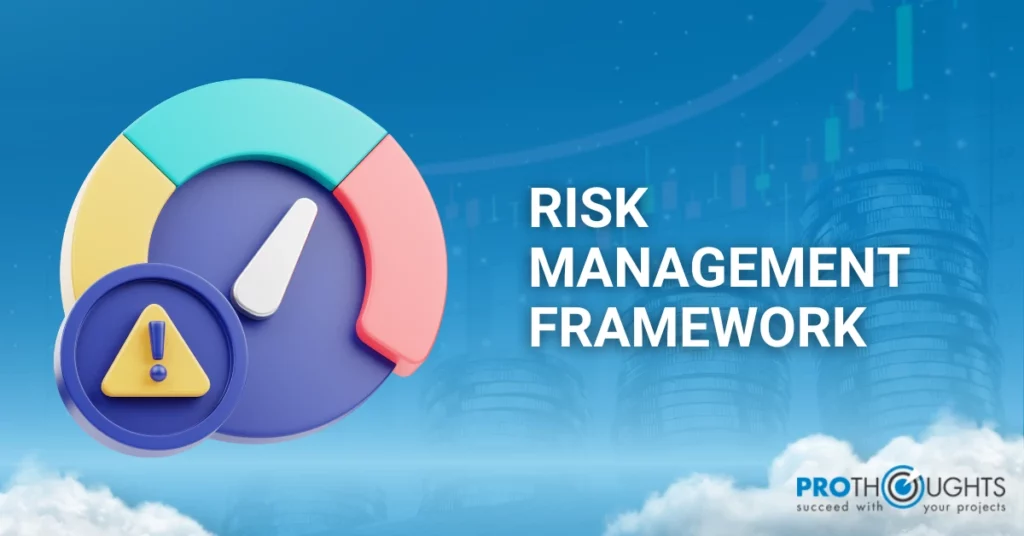With the growing complexity and dynamism of business enterprises, a strong risk management framework becomes even more pressing. A proven risk management framework allows its organization to determine potential risks, evaluate their impact, and choose the most adequate method of mitigation. This article discusses the critical components of a complete risk management framework. You, as a project manager taking the PMP certification examination or an entrepreneur, can greatly benefit from understanding these components to ensure the success and sustainability of your projects or ventures.
What is a Risk Management Framework?
The Risk Management Framework (RMF) works as a disciplined approach to organization risks and assists in identifying, measuring, and prioritizing the potential risk of reaching an end state. It offers a structured and holistic approach that helps manage and prevents risks in operations, project activities, or strategic plans. Furthermore, the main purpose of a Risk Management Framework is to improve decision-making by identifying and mitigating potential risks beforehand, thus reducing risk incidence as well as severity.
Key Elements of a Risk Management Framework
One of the most important organizational planning and decision-making components is risk management. It involves several key elements, with risk identification being a fundamental step. The following are the key components related to risk identification within a risk management framework:
1. Risk Identification
A. Methods for Identifying Risks
- Brainstorming – Inducing free discussions among team members that fuse their knowledge and expertise on potential risks.
- Documentation Review – Carrying out a conductive analysis of previous written documentation, contracts, and the project management plan that will cover any unseen risks in the running or operation.
- SWOT Analysis – Strengths, weaknesses, opportunities, and threats are evaluated using SWOT Analysis to determine risks.
- Consulting Experts – The interview of subject matter experts to get knowledge on potential risks associated with aspects specific to the project or operation.
- Scenario Planning – Drafting hypothetical situations to estimate potential hazards and their possible consequences for the organization.
- Historical Data Analysis – Analyze past projects or operations that have similar patterns to identify risks of repeating instances in the current situation.
B. Importance of a Comprehensive Risk Inventory
- Early Intervention – Working through a comprehensive risk inventory means that problems can be identified early, and steps taken to minimize or manage those risks.
- Decision Support – A thorough inventory informs decision-makers of potential risks from a project/operation enabling them to make informed decisions.
- Resource Allocation – As a knowledge tool, with an extensive risk inventory established, organizations will be able to channel resources in the right direction for investments in controllable risks.
- Stakeholder Communication – An encompassing risk inventory encourages proper communication among stakeholders as all the parties are aware of potential risks and how they will be dealt with.
- Continuous Improvement – Consistently updating and refining the inventory of risks enables organizations to respond flexibly to changes in circumstances, as well as further improve their risk management solutions.
However, the proper identification of risks requires multiple approaches, such as brainstorming and expert interviews. Additionally, the necessity of having a full risk inventory is clear because it helps with early intervention, decision-making support, and efficient resource allocation as well as stakeholder communication in addition to continuous development towards better organization practices for managing risks.
2. Risk Assessment
A. Quantitative vs. Qualitative Risk Assessment
Quantitative Risk Assessment
It is related to the numbering of risks, usually with financial numbers such as economic impact or probability. Additionally, data Utilization Requires specific and measurable data, often historical or statistical, to quantify the likelihood and impact of identified risks. Moreover, it provides a precise and numerical understanding of risk exposure, aiding in more accurate decision-making. Therefore, the situation may be complicated if reliable quantitative data is unavailable or when risks are difficult to define unequivocally.
Qualitative Risk Assessment
This focuses on non-numerical properties of risks that include the nature, impact, and judgments attached to them. Moreover, data Relies on expert opinions, as well as subjective appraisals and qualitative information to classify risks in terms of their importance. Moreover, it is useful when quantitative data is scarce, offering a broader understanding of risks based on expert knowledge and experience. Thus, a subjective nature may lead to variations in interpretations, and it may lack the precision of quantitative assessments.
B. Risk Scoring and Prioritization
Risk Scoring
Involves assigning scores or values to risks based on predetermined criteria, considering factors such as probability, impact, and severity. The likelihood of the occurrence, severity of impacting objectives, and risk appetite are typical scoring criteria. Employs a scale, such as 1-5 or low to high level of risks to facilitate their quantification and comparison between each other which are easily analyzable. Produces a quantitative model of risks, enabling comparisons and prioritization objectively.
Prioritization
Identifies and focuses on addressing the most significant or critical risks first. Some of the prioritization methods include ranking risks based on their scores, using risk matrices or decision tree approaches. Considering the probability and consequences of risks, addressing organizational objectives as well as risk tolerance. Prioritization is a dynamic process of constantly adjusting to the changing risk landscape and allocating resources optimally.
Yet risk assessment requires a decision between quantitative and qualitative methods of analysis, depending on the availability of information to support it and its characteristics. Moreover, risk scoring and prioritization are essential steps that enable organizations to quantify risks systematically relying on a structured and objective approach.
3. Risk Mitigation
A. Developing Strategies to Manage Risks
1. Risk Avoidance
It involves altering the project management plan or avoiding certain activities to eliminate the potential for specific risks. For example, choosing not to pursue a high-risk component in a project to mitigate associated uncertainties. When there are severe consequences to a risk, the risk is not worth taking.
2. Risk Reduction
It aims to reduce the probability or severity of foreseen risks. For example, implementing redundant systems to reduce the likelihood of system failure. Thus, target specific aspects of risks to make them more manageable.
3. Risk Transfer
Involves changing the financial implications or accountability for a risk to another party, typically through contracts and insurance. For instance, buying insurance shifts the financial cost of some risks onto an insurer. So, a clear contractual agreement must be in place and parties must understand one another.
4. Risk Acceptance
Recognizing the presence of a risk and leaving it unmanaged. For instance, choosing that the cost of addressing a risk with low impact and small probability is more significant than what could be gained. When mitigation costs are prohibitive or when risks have minimal impact or probability.
5. Exploit Opportunities
It involves taking proactive steps to exploit positive risks or opportunities. For instance, allocate resources to accelerate the completion of the project at a time when market condition favors it.
Therefore, to improve the effectiveness of a project it is crucial to evaluate possible opportunities and capitalize on them.
B. Implementing Controls and Safeguards
1. Control Implementation
Putting in place measures to monitor, manage, and control the identified risks and for example, implementing access controls and security measures to protect against data breaches. Also, involves a combination of policies, procedures, and technical controls.
2. Safeguard Installation
Enacting protective measures to avert, identify, or react against impending dangers. For instance, putting firewalls and anti-virus software to protect from cybersecurity threats. Further, for the consistent application of safeguards, a proactive approach is necessary.
3. Training and Awareness
Learning the risks and prevention measures already in place for employees as well as stakeholders. For instance, cybersecurity training to improve awareness and mitigate the risk of phishing incidents. In addition, human factors are important; training develops a risk-aware culture.
4. Continuous Monitoring
Frequent monitoring and evaluation of the controls to determine their effectiveness. For instance, periodical security audits to seek and eliminate possible weaknesses. In addition, ensures that risk mitigation measures are kept relevant to evolving threats and situations.
Besides, risk mitigation involves creating plans for project risk management that may include avoiding, reducing, transferring risks, and accepting the remaining or seizing of opportunities. Additionally, the introduction of controls and safeguards increases the effectiveness of risk mitigation activities through practical methods for tracking managing, and preventing potential dangers. Therefore, ongoing observation and reflection on the measures are necessary to keep up with their effectiveness over time.
5. Monitoring and Review
A. Continuous Monitoring of Risks
1. Real-Time Surveillance
It is based upon continuous monitoring and observation in real-time of the risks that have been identified along with their indicators. For example, implementing automated systems to monitor network traffic for potential cybersecurity threats. In addition, allows quick answers to new risks and riskscapes.
2. Key Performance Indicators (KPIs)
Different KPIs concerning risk factors are defined and monitored to evaluate the effectiveness of the selected strategies for managing risk. For example, monitoring project timelines, financial metrics, or compliance indicators to identify deviations. Also, it provides measurable benchmarks for assessing risk mitigation success.
3. Incident Reporting Systems
Implementing systems for reporting and documenting incidents related to identified risks. For example, setting up a platform for employees to report security incidents or project delays. Also, encourages a transparent and responsive approach to risk management.
4. Trend Analysis
Analyzing historical data and patterns to identify trends in the occurrence and impact of risks. For example, examining past incidents to detect recurring issues and areas requiring additional attention. It Enhances proactive risk management by identifying patterns and potential future risks.
B. Periodic Reviews and Updates
1. Regular Risk Assessments
Conducting scheduled assessments to reassess the risk landscape and update risk profiles. For example, performing quarterly reviews to identify new risks or changes in the severity of existing ones. It makes sure risk management strategies remain in sync with organizational goals.
2. Documentation Updates
Regularly updating risk documentation, including risk registers, mitigation plans, and communication strategies. For example, revising risk registers to reflect changes in risk scores or the implementation of new controls. Also, maintains the accuracy and relevance of information used in decision-making.
3. Stakeholder Communication
Providing quarterly updates to stakeholders on the risk management practices undertaken, results achieved and any changes made. For instance, holding periodic meetings or communicating reports to keep stakeholders informed of the progress on risk mitigation efforts. It advocates for accountability and facilitates stakeholder involvement in risk management procedures.
4. Adaptation to Organizational Changes
Adjustments to risk management strategies about organizational changes like expansion, mergers, or change preferences. For instance, re-evaluating risks and mitigation strategies when venturing into new markets or introducing technological innovation. It aligns risk management with strategic and organizational goals.
Furthermore, effective monitoring and review involve continuous surveillance of risks through real-time systems, KPI tracking, incident reporting, and trend analysis. Periodic reviews and updates ensure that risk assessments, documentation, and communication strategies remain current, allowing organizations to adapt to evolving risks and organizational dynamics. Therefore, this ongoing monitoring and review cycle is essential for maintaining a proactive and responsive approach to risk management.
Conclusion
The journey towards mastering these elements is seamlessly complemented by enrolling in PMP certification online training. Empower yourself with the knowledge and practical skills needed to implement a robust risk management framework. So, take the next step in your project management journey, where theory meets application, and success becomes a tangible outcome. Don’t just manage risks; conquer them with confidence and competence. Let’s enroll now and navigate your projects towards unparalleled success!





